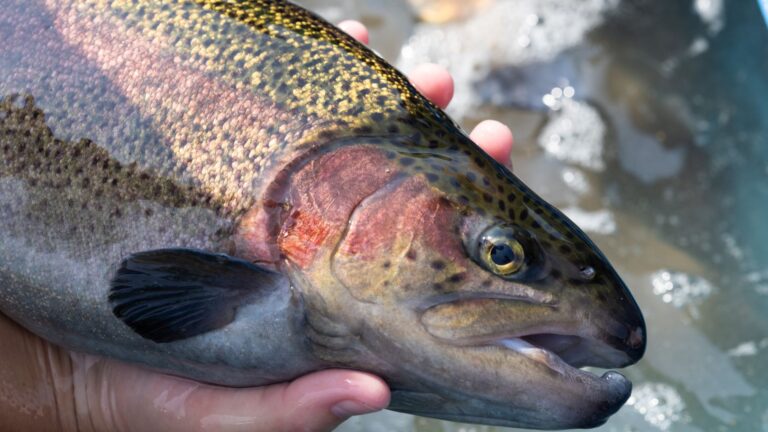
“But your farm could have an impact on the environment”
Our farms do have an impact, but why do we assume that’s a bad thing?
All the waters from our farms eventually make their way into Lake Huron — a lake that scientists recently called a “biological desert”.
It’s a desert because there’s been such a decline in nutrients over the last 50 years owing to invasive species and human impact. The lake doesn’t have enough food for all the critters at the bottom of the food chain, which means declines in those at the top like lake whitefish and trout.
The crystal clear waters may look good for photos, but if you can see 50 feet down to the bottom, that means there is very little living in that water.
At our farms we do our best to catch stray nutrients before they leave the farm, but a small part heading downstream is unavoidable.
But scientists now say those nutrients could be an important tool in bringing back the wild fish in Lake Huron.
A 10-year study from Lakehead University and Fisheries and Oceans Canada showed that lake trout populations doubled after five years of a farm operating in an experimental lake similar to Lake Huron. With additional nutrients, first the macroinvertebrates and zooplankton thrived, then eventually the smaller and bigger fish too.
In the last two years scientists at the University of Guelph have analyzed stable isotope and fatty acid signatures (referred to as biotracers) in the wild fish to look for evidence that these fish ultimately benefit from aquaculture inputs around farms in Lake Huron. They came to similar conclusions that fish farms could have a positive effect on local fish communities.
“Like the Experimental Lakes Area study, our biotracer analysis supports the hypothesis that local wild fish, especially pelagic fish such as cisco and lake trout, could benefit from the presence of fish farms by incorporating excess feed into their diets,” said Dr. Neil Rooney, from U of G’s School of Environmental Sciences. “The strongest evidence of these energetic subsidies was found in Parry Sound, whereas signals were weaker around the North Channel operations.”
That doesn’t mean we should put fish farms everywhere, or put as much nutrients as we can into the lake. It’s very important that we don’t overload nutrients in one place that can cause nuisance algae, like a bay with very little water exchange. That’s why we do such rigorous water testing and river studies, and also why regulators ensure we do plenty of environmental testing before a new farm goes in (and why it took our parents 9 years to site their first farm)!
And what about viruses or sea lice transferring to wild fish? Well we are very fortunate in the Great Lakes that we don’t have many of these things to worry about, in part because they don’t live in fresh water and also because it gets so cold nothing survives anyways! (Though we do full viral and bacteria screening on our fish before transferring them between farms, just to be sure.)
Sometimes we see products or companies use clever marketing to persuade us that we can consume without an environmental impact. They use green labels, carbon offsets, or a promise to recycle. But often those promises look at one thing (like zero water discharge) and ignore everything else (high carbon emissions).
Everything we do has an environmental impact. It’s not about believing we can have no impact, but rather about having as little impact as possible.
Or in the case of fish farming, having a positive impact.
On your next Springhills dinner, you can feel confident you’re eating fish that is:
- humanely raised
- very low carbon emissions thanks to gravity and nature
- environmentally regulated
- eco-certified (which involves even more water testing)
- and is linked to regenerating Lake Huron to bring the wild fish back!


